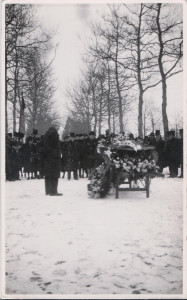Here is an overview of the new sources, projects, and other news announced in the past month. Sources The Staten van Oorlog [War Rosters] 1595-1795 are now available via the Brabants Historisch Informatie Centrum. These rosters include information about various people who held important positions in the Dutch army, such as officers who led companies, watch commanders, ministers, etc. The rosters provide detailed information about the structure of the army at the level of individual … [Read more...]
Map of the week – Reclaimed land in North Groningen, 1685
This week's map shows us land that was reclaimed from the sea by building a dike in the north of the province of Groningen. This includes land in the parishes of Hornhuizen, Wierhuizen, Pieterburen, Westernieland, Saaxumhuizen, Den Andel, Breede, Warffum, Usquert, and Uithuizen. The map was created in 1685 and lists all the owners of the land. Maps like this can be a great source of information to learn about property owned by your ancestors. … [Read more...]
Map of the Week – Plan to drain the South Sea, 1891-1892
In 1891, Cornelis Lely came up with a plan to claim more land from the sea. His ambitious plan involved building a dike between North Holland and Friesland to close off the Zuiderzee [South Sea]. That would make it possible to reclaim large sections of land and create a fresh water lake, the IJsselmeer. This plan formed the basis of a major water engineering project carried out in the first half of the 1900s. In 1932, the dike was completed. The southern (Flevopolder) and eastern (Noordoost … [Read more...]
Yvette Hoitink, MLitt!
Today I graduate with a Master of Letters in Family and Local History from the University of Dundee. My grades allowed me to graduate with Distinction, the highest award that the university bestows. I started my studies during lockdown in 2020. I am not one to grow indoor tomatoes or bake sourdough bread, so I went and did a master's instead. This degree was completely via remote study, which made it a perfect choice for me. The Netherlands does not offer academic programs in genealogy, so … [Read more...]
Map of the week – Maastricht, 1585
In 1585, Braun and Hogenberg published an atlas with maps of different cities in Europe, including many in the Netherlands. This map shows Maastricht. What is nice about these maps is that it shows the people in their local costumes. It shows all the houses in the city, and you can see the different expensions. The detail shows the main church in Maastricht, the St. Servaas. The blue color of the roof indicates it is an untaxed building, usually either religious or city buildings. You can see … [Read more...]
Dutch Genealogy News for June 2024
Here is an overview of the new sources, projects, and websites that were announced last month. Sources Death records of Suriname (1846-1915) have been digitized and indexed and are available on the website of the National Archives of Suriname. The Ward Registers of Paramaribo, Suriname 1828-1847 have been digitized and indexed and are available on the website of the National Archives of Suriname. The ward registers are annual recordings of all the free people living at each address. … [Read more...]
Map of the Week – Goes, 1867
Between 1865-1868, Jacob Kuyper published a series of atlases with municipal maps. These show the location of all the hamlets, villages, and larger towns in the municipality, as well as the main roads and railroads. The Kuyper maps are often available at the websites of archives or via Wikimedia Commons. This week we are looking at Kuyper's map of Goes, in the province of Zeeland in 1867. It shows that Goes had a railroad connection to Bergen op Zoom and a railway station just south of the … [Read more...]
Dutch term – Lijkschouwing
Lijkschouwing literally means corpse-assessment. It is the term for the assesment by a doctor after a person died, to determine whether the person died of natural known causes, natural unknown causes, or unnatural causes. This is typically done by the doctor treating the patient or the doctor who was on call when the patient died. If unnatural causes are suspected, the doctor will inform the municipal coroner and an autopsy is usually performed. This is how it is under the current law (1991). … [Read more...]
Map of the Week – Tourist map of Oisterwijk, 1933
This week we are looking at a tourist map of Oisterwijk from 1933. It is a "wandelkaart" [walking map], which highlights various natural features like lakes (blue), forests (green), national forests (orange), swamps (blue horizontal stripes). It features the hotels in the area and places of interest including churches, a swimming pool, and cafes. The early 1900s saw the rise of tourism for the middle and upper classes. Railroads allowed people to travel across the country affordably and … [Read more...]











